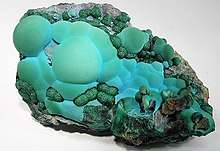Botryoidal
A botryoidal texture or mineral habit is one in which the mineral has a globular external form resembling a bunch of grapes (botrys in ancient Greek).[1] This is a common form for many minerals, particularly hematite, the classically recognized shape. It is also a common form of goethite, smithsonite, fluorite and malachite. This includes chrysocolla.

Each sphere (grape) in a botryoidal mineral is smaller than that of a reniform mineral, and much smaller than that of a mamillary mineral. Botryoidal minerals form when many nearby nuclei, specks of sand, dust, or other particles, are present. Acicular or fibrous crystals grow radially around the nuclei at the same rate, appearing as spheres. Eventually, these spheres abut or overlap with those that are nearby. These nearby spheres are then fused together to form the botryoidal cluster.
References
- Adjective form: botruoeidēs – https://en.oxforddictionaries.com/definition/botryoidal
- Klein, Cornelis and Cornelius S. Hurlbut, Jr.; 1985; Manual of Mineralogy; Wiley; 20th ed.; p 199; ISBN 0-471-80580-7
- http://www.minerals.net/mineral_glossary/botryoidal.aspx
- http://www.britannica.com/EBchecked/topic/75161/botryoidal-texture